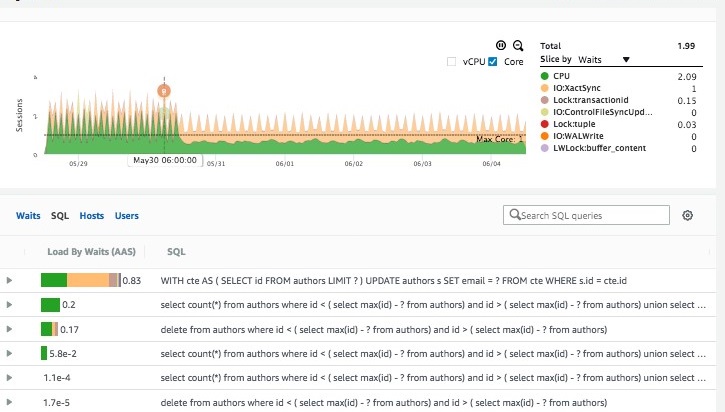AWS Database Blog
Tag: Amazon RDS
Build a notification mechanism to manage Amazon RDS manual snapshots
It’s no secret that data is an essential part of running a business, no matter how large or small a business may be. Many companies host their business data using relational databases. As a result, backup and recovery are important aspects of keeping the business running. Amazon RDS customers use a mixture of strategies to […]
Amazon RDS Performance Insights is now generally available
Today we are pleased to announce general availability of Performance Insights. Already available since October 2017 as an open preview with Amazon Aurora with PostgreSQL compatibility, Performance Insights makes it easy to view the load on an Amazon RDS database. Using Performance Insights, you can more easily identify bottlenecks and discover what to do when […]
How to set up a Binlog Server for Amazon RDS for MySQL and MariaDB using MariaDB MaxScale
One of the key features of Amazon RDS for MySQL and Amazon RDS for MariaDB is the ability to create Read Replicas. You can easily create up to five replicas for a single master database instance via the AWS Management Console or the AWS CLI. Amazon RDS then handles all the work of making a […]
How to use IAM multifactor authentication with Amazon RDS
A common request that we get from customers is how to protect their resources from an accidental or malicious deletion, such as instances, snapshots, clusters, and so on. Doing this is especially important when you are using a common AWS account for multiple users or teams. Although you want the flexibility to innovate within the […]
Using AWS Cost Management products to help save costs on Amazon RDS Reserved Instances
Using Amazon RDS, you can quickly and easily set up, operate, and scale your relational databases in the cloud. Amazon RDS Reserved Instances (RIs) give you the option to reserve a database instance for a one- or three- year term. This option can translate into significant discounts (up to 69%) compared to On-Demand prices. In […]
A Case Study of Tuning Autovacuum in Amazon RDS for PostgreSQL
In a PostgreSQL database, the autovacuum process performs multiple critical maintenance operations. In addition to freezing the transaction ID to prevent it from wraparound, autovacuum also removes dead tuples to recover space usage. For databases with a high volume of write operations, it is recommended that you tune autovacuum to run frequently. Doing this helps […]
Introducing Ongoing Replication from Amazon RDS for SQL Server Using AWS Database Migration Service
We are excited to announce a new feature in AWS Database Migration Service (AWS DMS) and Amazon RDS for SQL Server that supports ongoing replication from Amazon RDS for SQL Server sources. AWS DMS helps you migrate databases to AWS quickly and more securely. It also helps you migrate data within AWS. You can migrate […]
Best Practices for Upgrading Amazon RDS for MySQL and Amazon RDS for MariaDB
One key feature of Amazon RDS is that you can easily upgrade a database instance to a new minor or major version of your database engine. You can perform upgrades on demand by using the AWS Management Console or AWS CLI. You can decide to automatically upgrade to a new minor engine version when it […]
Australia Finance Group’s Journey to Cloud Databases: Migrating from Oracle Exadata to Amazon RDS
Australia Finance Group (AFG) is one of the largest mortgage aggregators in Australia, according to the Mortgage and Finance Association of Australia. AFG migrated their Oracle Siebel Customer Relationship Management (CRM) application to a managed database with Amazon RDS for Oracle. In this blog post, we describe their approach to migrating the database from Oracle […]
Replicating Amazon EC2 or On-Premises SQL Server to Amazon RDS for SQL Server
Amazon RDS for SQL Server is a managed Microsoft SQL Server database service that makes it easy to set up, operate, and scale SQL Server deployments in the cloud. Amazon RDS takes away the time-consuming database administration activities so that you can focus on your schema design, query construction, query optimization, and building your application. […]









